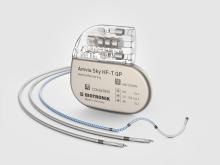Electromagnetic Interference and Your Device
We encounter electromagnetic fields everywhere in our daily lives. Those fields, which are generated by all electrical devices, can cause electromagnetic interference (EMI). This means that they can affect the performance of another electronic device within its proximity. While in most cases these fields are too weak, some medical procedures, household appliances or equipment with strong energy fields may temporarily interfere with how your pacemaker, defibrillator or CRT device works. This page will explain what to watch out for and where to find more information.

How Your Cardiac Implant may be Affected
If the electromagnetic field surrounding an electrical device is too strong and too close to your implanted heart device, it may temporarily affect its functionality. It may cause your device to deliver a therapy that is not needed or withhold a therapy that is needed. In other words, a pacemaker may not be able to deliver a pacing pulse or may unnecessarily speed up the heart rhythm. An ICD in close proximity to a strong electromagnetic field may be prevented from delivering or may deliver undesired defibrillation shocks.
How To Avoid Electromagnetic Interference
While electromagnetic interference may sound like a topic of concern, especially if you are about to receive a cardiac implant or you or a family member have recently received one, you will quickly discover that it can be managed well. Our “Electromagnetic Compatibility Guide” shows you which items pose no risk, which ones have a limited risk and which items or procedures should only be used with due care.
In most cases, though, it is enough to maintain a minimum distance between your implant and certain electrical items such as smartphones, household appliances or electric tools. If you suddenly feel lightheaded, a change in heart rate or dizzy, stop touching or move away from the electrical item near you. The cardiac pacemaker or defibrillator will be fully functional again as soon as the distance to the source of interference increases or is switched off.
What Else You Can Do
If you carry a pacemaker, defibrillator or CRT device:
- Ask your doctor whether there are procedures or devices which you should not use because of your device and disease.
- Ask your doctor whether there are any devices you must not use during your daily professional work.
- Prior to any medical or dental treatments, inform the doctor that you have an implanted pacemaker, defibrillator or CRT device.
- Before using electrical devices, observe the manufacturer's warnings for patients with cardiac pacemakers/ICDs.
- If you are planning to travel soon, please familiarize yourself with our “Travel” section with relevant tips for approaching the security control at airports.
- Take a few minutes to read BIOTRONIK’s “Electromagnetic Compatibility Guide” which is designed to quickly identify which items and procedures pose no risk and which ones shall be handled with due care.
